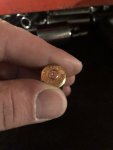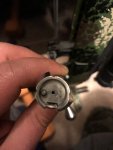New at this and know just enough to be dangerous. So I bought a new tikka 300wsm and screwed a proof carbon fiber shouldered prefit on, checked the head space with a go gauge then put a piece of masking tape over the back of the gauge for a no go gauge and the bolt closed... hmm so I put 2 pieces of tape on ... didn’t close. Measured both pieces at around .005 - .006 (barrel was torqued at 75ftlbs at this time). So I Forgot about the ptg go gauge, tape, and torque wrench and just cranked the action down tighter and ran 4 rounds through it (I was in the fuck it mode at this point after getting the factory barrel off) Hornady and federal factory rounds had ejector flow and hard/ really hard bolt lifts. I then measured the headspace on the fired brass against the unfired brass and had .006 difference on the hornady and .004 on the federal. Made sense to me because the hornady bolt lift was harder. Is this too much headspace? I know when I reloaded 308 I always went for .002 difference. I tried contacting proof but they are not open on the weekends and have a go/no go gauge set coming in the mail. Am I on the right track thinking it’s a headspace issue? Any Ideas or thoughts in the mean time would be much appreciated.
.006" case length difference between virgin and fired brass is not unusual. It only stretches that much once, after that you're only bumping back .001-.002". When firing virgin brass the longer headspace can cause false high pressure signs in the form of ejector swipe marks. If the primer hasn't flattened, it's likely a false pressure sign. The swipe mark is caused by the case slamming back into the bolt face.
A word about the relationship between barrel torque and headspace. The greater the torque, the greater the headspace. The barrel tenon threads are stretching. At 100 ft/lbs it is about .002". So, you increased torque past 75 ft/lbs to an unknown higher level - you just increased headspace. It may not be much, but if you thought you were "squeezing" the headspace smaller, you've got it backwards.
Take your now once fired brass, measure cartridge base to shoulder. Adjust your sizing die to bump back .001-.002", reload, shoot, and check for any
new pressure signs. Best practice is to index the case so that the ejector is not sitting on top of the prior ejector swipe - mark the swipe with a sharpe. If there are two swipe marks, one is new.
If you call Proof and explain the bolt closed on a Go Gauge w/tape, they might offer to take the barrel back and take a thou or two off the shoulder which will reduce headspace (or ask you to try a real No-Go gauge). Ideally, when chambering/fitting a barrel, the bolt closes on a Go gauge, and does not on a No-Go gauge. I've seen factory rifles which do close on a No-Go. It doesn't mean that they have dangerous headspace, just that the brass is growing more and subsequent brass life will be decreased. It's why hand loaded ammo may work in one rifle, but not another.



